Growing Tomatoes
Lycopene and Tomatoes
Lycopene and tomatoes – what’s the big deal, anyway? And for that matter…what is lycopene? Let’s talk about the tomato-lycopene connection, because there is a strong one.
What is Lycopene?
First, what exactly is lycopene? And did you know it was actually named after the humble tomato?
Lycopene is a powerful antioxidant, high in beta-carotene. Its name comes from the tomato’s Latin name, Solanum lycopersicum. Probably because tomatoes are pretty much the best source of lycopene!
Although there hasn’t been enough research as yet, there appears to be a correlation between a higher lycopene intake and the reduced risk of cancer, particularly of the prostate and testes. Guys, eat your tomatoes!
Ladies, don’t feel left out — there’s also a correlation between lycopene and a reduced risk of breast cancer.
As an antioxidant, lycopene has been shown in lab testing to be 100 times more effective than vitamin E — wow! And since the kind of oxidant that’s targeted is produced by ultraviolet light, lycopene is essential for anti-aging skin care.
Have I given you enough reasons for eating lycopene? Now let’s talk about the tomatoes.
Lycopene and Tomatoes
As I mentioned earlier, lycopene takes its name from tomatoes themselves. Are there special tomatoes that are highest in lycopene? Yes and no.
All tomatoes have lycopene, but certain colors have the highest amounts. The winners are the tomatoes with deep red flesh (which includes pink tomatoes because they really do have red flesh — read the tomato colors post for more info).
The paler (and farther way from red) the tomato, the less lycopene is found. So the white tomatoes have the least naturally occurring lycopene amounts.
So, what are some of the tomatoes with the deepest red flesh? Some of the more easily found heirloom tomatoes include:
- Brandywine (the pink and red versions)
- Druzba
- Eva Purple Ball
- Mortgage Lifter
There are also some hybrids which were developed to have a high lycopene component:
- Health Kick
- Tasti-Lee
A word on the Tasti-Lee tomatoes — you can often find them in grocery stores, but I would not suggest those — they are gassed to ripen them, and it’s the vine-ripened version that has the high lycopene. Grow your own Tasti-Lee if you want the extra lycopene.
So there you go with the tomato-lycopene connection. So that leads to the question…
…how many tomatoes can you eat before you have too much lycopene — and what are the side effects?
The side effects tend to be skin-related, as your skin can take on a yellowish or orangeish hue. Not to worry, it goes away if you cut down on your tomato indulgences! And you have to eat a lot of tomatoes to get that far — perhaps the equivalent of a dozen large (1-lb+) tomatoes a day, over a long period of time. As much as I love to eat tomatoes (and lots of ‘em), even I can’t manage that many a day, continuously. There are only so many tomato sandwiches, soups, salsas, salads and pasta sauces I can eat on a daily basis.
So eat your tomatoes! Enjoy them and know that by eating them, you are doing something wonderful for your body’s health.
P.S.
It’s really best that you grow your own tomatoes, and let them vine-ripen naturally. Tomatoes from the grocery store are almost always picked green, and then gassed to look ripe; as a result, their lycopene content is quite diminished. If you’re new to growing tomatoes, check out the tomato growing tips page — it’s fun and you can do it!
Tomato Colors
Tomato colors are kind of tricky; red isn’t the only color in the pallet. If you’ve spent any time with seed catalogs or read any books on tomatoes, you’ll see references to yellow, pink, orange, bicolor, striped, green, purple, chocolate, white and black. And now the pallet includes blue/indigo!
Still, the colors aren’t necessarily obvious. Nor do the same varieties of tomatoes grown in different climates have the same color. What’s a home gardener to do?
Notes on Color
In general, tomato fruit colors are more vivid in warm climates than the cooler climates. While it doesn’t always hold true (many reds, pinks and yellows are bright no matter where), others need warmer weather to color up.
Conversely, tomatoes like the white varieties need cooler weather to retain most of their white/ivory color. Grown in the sunny South, they’ll end up more yellow.
The shades that really need warmth to reveal their depth of color are the purple, chocolate and black tomatoes. If you grow these in the cooler climates, you may be disappointed as to the paleness of the colors of the ripe fruits, compared to what you see online or in catalogs (which tend to be grown in warmer climates).
Tomato Colors
The fruit colors are as follows:
- Red: No real need to explain this, as it’s what you see in the grocery store. Red tomatoes have red interiors and yellow skin.
- Pink: These are tomatoes with a red interior but clear skin; therefore, they appear pinker than the reds.
- Purple: Generally a richer, dusky pink, both skin and flesh.
- White: I have yet to see a white tomato (in my climate anyway) that stays white when ripe. They start out that way, but then develop ivory to light yellow tones. The best chance for a white tomato to stay almost all white is one grown in a cooler climate, and shaded by a lot of leaves.
- Yellow: A clear, lemony yellow, both inside and out.
- Gold: These are the tomatoes that start out as yellow, but turn a richer gold color when ripe.
- Orange: These are really orange-colored, although some are brighter than others.
- Green: The skin is mostly green when ripe, with an amber blush on the blossom end. The interiors tend to be an almost neon green.
- Chocolate: A dusky purple. If you’re not used to darker tomatoes, you might think these look very strange when ripe.
- Black: A much darker purple. Some people are put off by the color of the skin and flesh of a black tomato, but they really are very good!
- Bicolor: Generally these refer to the red and yellow colors. The interiors are usually a swirl of yellow and red — gorgeous when cut in half!
- Striped: Just as you might imagine, the exterior is striped. The interior is usually just one color though. Visually stunning!
- Blue (Indigo): A relatively new color, but not exactly blue. They have a lot of anthocyanin in their skins, and they actually can look rather blue when unripe. Then the blue color turns more of a dark purple as they ripen.
Quite a few choices, wouldn’t you say? As a special note, the more exotic colors are generally heirloom tomatoes. Hybrids tend to be in the red-pink-yellow range, with some orange and white thrown in for good measure. Naturally, there are exceptions (there are quite a few indigo hybrids popping up).
Do the Different Colors Taste Different?
There are no hard-and-fast rules as to correlating tomato color to tomato taste; it really depends on the tomato variety and the growing conditions.
That being said, some people think that:
- Green tomatoes taste “zippier”.
- Yellow, white and orange tomatoes have the reputation of being blander (although not necessarily bland). But there are plenty of them that are very tomatoey tasting!
- Pink and purple tomatoes have the richest tastes and creamiest textures.
- Black and chocolate tomatoes have a deeper taste, less sweet.
- Bicolor and blue/indigo tomatoes are kind of all over the place. Most are just nice.
- Red tomatoes are the most common and range from bland (usually the store-bought ones) to very rich and luscious.
But like I said, it really does depend on the variety you grow. Not all tomatoes of a different color are alike!
Tomato Growing Tips
These tomato growing tips are for inexpensive ways to stretch your gardening budget. After all, part of the reason for gardening is so you pay less for vine-ripe tomatoes! Not to mention the deliciousness of homegrown tomatoes. 😀
There’s a book out on the $64 tomato, where a gardener says that after he tallied up all his costs associated with his tomato plants, and divided it among the tomatoes harvested, it came to something like $64 a tomato.
No, it doesn’t cost that much! I haven’t read the book, and I’m sure part is tongue-in-cheek. But it is true that if you don’t watch it, you, too can be spending a whole lot more than you intended.
Tip #1: Household Items
Some of the household items I like using include used (washed) pantyhose; cut them in wide strips and you can use them for tying up the tomatoes to their stakes.
Small 3-ounce Dixie cups are fantastic for germinating tomato seeds and really inexpensive (especially if you get the store brands).
Gallon containers like plastic milk jugs and tea jugs are great for mixing up fish and seaweed emulsion fertilizer drenches. Just remember to label the containers with their new ingredients! Two liter bottles are fine as well.
All kinds of household plastic and waxed paper containers can be used for temporary potting, before setting out in the garden. Just make sure to punch holes for drainage.
Tips For Fertilizers and Soil Amendments
Most fertilizers have a high nitrogen component, which is not what you want for tomato fruits! And most fertilizer instructions want you to apply them far too often. If you have enriched your garden soil with compost or composted manure, you will need far less fertilizer. I generally apply my fertilizer at half the strength suggested on the label instructions with good results.
If you have the room, set up a compost pile. depending on your climate it can take anywhere from a month to a year for finished compost, but your tomatoes will thank you. And since compost is made from food scraps you’d normally throw away, it’s a great way to recycle.
If you live in an area with cows or horses, see if you can arrange to cart away some of the manure; normally you can get your manure free this way — put it in your compost pile to make it even richer.
OK, what if you don’t have room for a compost pile (or you just don’t want one). Go to your local garden center and find a fertilizer which can be diluted before applying to the plants. One small box of Miracle Gro is pretty inexpensive (I like Miracle Gro for Roses) and lasts quite awhile.
Thoughts on Garden Equipment
If you have a small garden (100 square feet or less), try renting a tiller for a day or two instead of buying one. If, however, you have a larger garden, buying your own tiller may make sense for the long run.
A shovel, spade, hoe and pitchfork are really all the hand tools you need. The pitchfork is optional, and mainly used if you have a compost pile.
You can make your own tomato cages from concrete reinforcing wire; useful if you have a lot of tomatoes that need staking as they do seem to last forever. Rebar makes for good tomato stakes, if you have easy access to it. But if you have only a couple-three plants, you can use commercial tomato towers and cages and save yourself the trouble. I’ve found that most commercial cages/towers last quite a few years and tend to be easier to store.
Don’t have a lot of room for a garden? I’ve found the 5-gallon grow bags are great for medium-sized indeterminate tomato plants and are pretty inexpensive. You can go as small as 3-gallon for smaller and determinate tomatoes, and 10-gallon for the larger indeterminates.
Plants Versus Seeds
Hands down, it’s cheaper to plant seeds than buy tomato plants. Some of the best-producing tomato varieties may not be available as plants in your area. For $3, you can grow 20 to 40 plants from seeds…or you can buy one plant.
Keep in mind that if you store them in a cool, dry place, your tomato seeds will be good for several years. So if you don’t plant the whole pack this year, you automatically have seeds available for next (and the next…)!
Now it’s true that if you plant seeds you need to get some seed-starting soil; you don’t want to use anything from the garden, as it will have bacteria that may cause problems. But you’ll use very little per seed; a small 4-quart bag can be used for many, many dozens of seeds. Around here, the big-box garden centers (Home Depot, Lowe’s, etc.) carries the small bag for between $4 and $5.
You will also need a germination tray or two, but they are also inexpensive and last year after year. I had one windowsill mini-greenhouse that finally bit the dust…after 10 years.
Final Tomato Growing Tips
You really don’t need to spend a fortune to grow your tomatoes; household items will suffice in many situations, and other more permanent items (shovels, cages, etc.) will last many years if you treat them properly.
Not all tomato varieties produce the same number of fruits. Cherry tomatoes are far and away the most prolific! In general, the larger the tomato fruit size, the fewer the tomatoes produced. The heart-shaped tomatoes as a group tend to produce the least. For a continuous crop of larger (i.e. not cherry) tomatoes, go for the indeterminate plants whose fruits average around 6 to 10 ounces.
So go ahead; grow your tomatoes! And may your homegrown tomatoes be abundant and delicious-tasting.
Tomatoes For a New Gardener
If you’re just starting out with your garden, you may want to know some good “beginner” tomatoes. What are some tomato varieties that are easy to grow, good to eat and fun to watch develop?
Tip #1 for a New Tomato Garden
If you’ve never grown tomatoes before, I suggest growing just three plants your first season. Why?
First, you want the best chance for your plants to grow and produce tomatoes. This means that you’ll have to watch your plants and see how they react to your particular growing conditions. If you put your plants out into your garden too soon, they might get killed by frost or stunted by chilly weather. If you plant too late, you risk both the plants not pollinating well because it’s too hot, or your fruit not ripening fast enough before season end.
So, your first planting season shouldn’t be more than three tomato plants; the next season, after you become familiar with the growing conditions, you can plant with abandon!
Which Tomatoes for a New Gardener?
I suggest three different varieties for your tomato garden; a determinate, a cherry and an heirloom. These three will give you tomatoes both early on and all through the season.
Determinate: Determinate tomatoes tend to be smaller plants and bear fruit earlier. Many don’t even need staking, which is a plus for the beginning home gardener. Determinate tomatoes tend to be early-to-mid-season tomatoes, so they will be among the first of your homegrown tomatoes harvested. In general, I’ve found the determinate tomatoes to be a bit more resistant to diseases.
Cherry: A cherry tomato is one of the very easiest to grow, and the plants usually very prolific. Cherry tomatoes are small (usually less than 2 ounces) and are born in clusters…sometimes very large clusters of 10 or more tomatoes! Because the plants are so prolific, there are usually tomatoes ready at any given time. Great for salads and snacking. The cherry tomato plants are normally indeterminate, so they continue producing their fruit for the entire season.
Heirloom: Finally, I suggest an heirloom, because most taste absolutely divine! Heirloom tomatoes tend to be mid- to late-season, so they are ready for harvest after the determinate and cherry tomatoes produce. I like the beefsteak-style heirloom tomatoes for their truly tomato taste, and the fact that they make great tomato sandwiches!
So, those are the tomato types I suggest for the first-time tomato gardener. Now on to the varieties you can plant!
Tomato Variety Suggestions
I’ll give you two different groups of three. The first group should appeal to anyone; they are beautiful red tomatoes that are easy to grow.
The second group of three is for anyone who wants to get a little more adventurous. Instead of red tomatoes, you’ll find these in three different colors!
Group #1: Red Tomatoes
My three picks are: Celebrity, Supersweet 100 and Big Beef, and here’s why.
- I have found Celebrity to be a tried-and-true addition to my garden. The plants are easy to grow and it’s rare they need staking. The tomatoes are medium-sized and quite good — much better than the grocery store tomatoes. Beyond regular watering an a little fertilizer now and then, Celebrity produces without fuss.
- Supersweet 100 has been a great performer for me — the plants sprout and grow quickly. The cherry tomatoes are produced rampantly, once the plant has been established. It’s hard to go wrong with this plant, and the cherry tomatoes are very sweet. You will need to stake this plant, however.
- Matina is an early-season heirloom tomato that tastes better than an early-season tomato usually is. The easy to grow tomatoes aren’t all that big for this variety — maybe 3 or 4 ounces — but it’s rewarding to grow. It’s indeterminate, so you can expect it to produce tomatoes into mid-season.
Group #2: Tomatoes of Different Colors
For adventurous souls, here are my picks for different-colored tomatoes: Black Cherry, Clear Pink Early and Cherokee Purple.
- Determinate tomatoes are usually red, but Clear Pink Early is a pink determinate. It’s pink (as you might guess from the name), is relatively compact, and early season.
- Black Cherry is my suggestion for cherry tomatoes. I’ve had great luck with this cherry tomato, but what about the black? They aren’t a true black, but rather a dark dusky color. This is a mid-season indeterminate tomato; it can grow very large and be very prolific. And delicious!
- My final choice is Cherokee Purple. Cherokee Purple is one of the more widely-adapted of the heirloom tomatoes, and pretty easy to grow no matter where you are. A mid- to late-season producer, Cherokee Purple has medium to large fruits, with a heavenly tomato taste. Now as to the purple. never fear, the tomatoes are really a deep pink tinged with brown (much prettier than how it sounds). No neon colors! Altogether one of the nicest and easiest of the heirlooms to grow.
A Word to Florida Gardeners
Summers are brutal in Florida, and hard on the tomatoes; they just don’t pollinate or set fruits well in high temperatures. So, I grow my main crops in two seasons — Spring and Fall.
For a Spring crop, you’ll want to plant seeds by the middle of February (end of January is better). This way most of your tomatoes will be harvested before the temperatures get really hot. Your cherry tomatoes may continue to produce fruits, though, into the summer heat.
For a Fall crop, plant seeds by the end of May; a bit earlier if you live in the inland North Florida and Panhandle area, where it gets cooler sooner.
I can and sometimes do plant crops for Summer and Winter, seeing as I live in South Florida. However, I plant the fewest tomatoes then. While I may have a few dozen tomato plants in Spring and Fall, I may grow only 3 or 4 most summers and winters. But for the beginning tomato gardener in Florida, I don’t recommend starting out with a Summer crop — the chance of tomato diseases is higher, due to the heat and humidity. Spring will be easiest for you.
Germinating Tomato Seeds, Update
In my previous post about germinating tomato seeds, I mentioned that I had planted quite a few seeds that were at least 10 years old. While I expected some of these seeds to germinate (I do have some rare seeds in my collection), I wasn’t expecting a high germination rate. At most, I was hoping 25%.
Wow, have I ever been surprised! For some of the varieties, the germination rate has been in the neighborhood of 75%. Brandywine is one of them; Yellow Cherry another. Then there are varieties in the 60% range, like Pineapple and White Bush. Of all the varieties I planted, only Big Rainbow has had a low germination rate. Then again, it might be that it’s been slower and more seedlings will start popping their heads above ground today or tomorrow.
I’m trying to decide if the Terracycle I sprayed on the soil on Sunday helped the germination, or at least hastened it. Sunday hadn’t shown much action with the seeds, but Monday a whole bunch showed up. Tuesday a whole lot more. And even today I see some more new seedlings starting through the soil.
The next batch of seeds, I’ll remember to spray the Terracycle sooner (my fault, my plant sprayer had disappeared and I had to go get a new one…and was a bit slow about it). But now I have a new sprayer.
There’s a Problem, Though…
I have a problem now, but it’s a good one to have. I planted way more seeds than I had needed, because I thought the germination rate would be really low. Yikes! I now have way more tomato plants than I have containers, by a large margin. Time to gift my family and friends with some seedlings, or maybe take them to a farmer’s market to sell, in another month or so (after the second transplant).
So, don’t throw out those old seeds without giving them a try, and keep in mind that they may take somewhat longer to germinate than newer seeds. Remember, when germinating, tomato seeds like warmth and humidity.
I’ll give another update next week on how the seedlings are faring.




